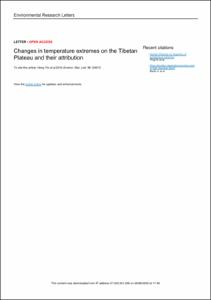Mostra el registre d'ítem simple
Changes in temperature extremes on the Tibetan Plateau and their attribution
| dc.contributor.author | Yin, Hong |
| dc.contributor.author | Sun, Ying |
| dc.contributor.author | Donat, Markus |
| dc.contributor.other | Barcelona Supercomputing Center |
| dc.date.accessioned | 2020-06-29T16:42:53Z |
| dc.date.available | 2020-06-29T16:42:53Z |
| dc.date.issued | 2019-11-27 |
| dc.identifier.citation | Yin, H.; Sun, Y.; Donat, M. Changes in temperature extremes on the Tibetan Plateau and their attribution. "Environmental Research Letters", 27 Novembre 2019, vol. 14, núm. 12, 124015. |
| dc.identifier.issn | 1748-9326 |
| dc.identifier.uri | http://hdl.handle.net/2117/191925 |
| dc.description.abstract | The Tibetan Plateau (TP) is the largest and highest upland on Earth. Warming on the TP is faster than that in surrounding areas. Evaluating our understanding of the causes behind these changes provides a test of tools used for projections of future climate in the region. In this study, we analyse the observed changes in twelve extreme temperature indices and compare them with model simulations based on the Coupled Model Intercomparison Project Phase 5 (CMIP5). An optimal fingerprinting method is used to perform detection and attribution analyses on the changes in absolute intensity, percentile-based frequency, fixed threshold exceedances of temperature extremes and diurnal temperature ranges in the central and eastern TP. The results show that during 1958–2017 the TP has experienced increasing intensity and frequency of warm extremes and decreasing intensity and frequency of cold extremes, with almost all these changes larger than those in China and East China. The detection results and attribution analyses show that the anthropogenic (ANT) signal can be robustly detected in the trends for all extreme indices on the TP, and the natural (NAT) signal in some cases, too. The attributable contribution from ANT is estimated to be much larger than that from NAT for most indices. The study also indicates that the CMIP5 models may underestimate the magnitude of warming in some temperature extremes, especially the indices related to cold extremes. This should be kept in mind when informing adaptation decisions on the TP with projections based on the same models. |
| dc.description.sponsorship | We thank Dathi Stone and an anonymous reviewer for their insightful and very helpful comments. We acknowledge the Program for Climate Model Diagnosis and Intercomparison and the Working Group on Coupled Modeling of the World Climate Research Programme (WCRP) for their roles in making the WCRP CMIP multi-model datasets available. This study is supported by the National Key R&D Program of China (2018YFA0605604, 2018YFC1507702), the National Science Foundation of China (41675074) and Climate Change Project (CCSF201920), MGD has received funding by the Spanish Ministry for the Economy, Industry and Competitiveness Ramón y Cajal 2017 grant reference RYC-2017-22964. We thank the China National Meteorological Information Center for archiving the observational data (available at http://data.cma.cn/). |
| dc.format.extent | 12 p. |
| dc.language.iso | eng |
| dc.publisher | IOP Publishing Ltd |
| dc.rights | Attribution 3.0 Spain |
| dc.rights.uri | http://creativecommons.org/licenses/by/3.0/es/ |
| dc.subject | Àrees temàtiques de la UPC::Desenvolupament humà i sostenible::Degradació ambiental::Canvi climàtic |
| dc.subject.lcsh | Tibet, Plateau of |
| dc.subject.lcsh | Databases |
| dc.subject.lcsh | Global warmin |
| dc.subject.other | Detection and attribution |
| dc.subject.other | Tibetan Plateau |
| dc.subject.other | Extreme temperatures |
| dc.subject.other | Anthropogenic forcing |
| dc.subject.other | Natural forcing |
| dc.title | Changes in temperature extremes on the Tibetan Plateau and their attribution |
| dc.type | Article |
| dc.subject.lemac | Canvis climàtics |
| dc.subject.lemac | Escalfament global -- Models matemàtics |
| dc.subject.lemac | Bases de dades |
| dc.identifier.doi | 10.1088/1748-9326/ab503c |
| dc.description.peerreviewed | Peer Reviewed |
| dc.relation.publisherversion | https://iopscience.iop.org/article/10.1088/1748-9326/ab503c |
| dc.rights.access | Open Access |
| dc.description.version | Postprint (published version) |
| dc.relation.projectid | info:eu-repo/grantAgreement/MINECO/2PE/RYC-2017-22964 |
| local.citation.other | 124015 |
| local.citation.publicationName | Environmental Research Letters |
| local.citation.volume | 14 |
| local.citation.number | 12 |
Fitxers d'aquest items
Aquest ítem apareix a les col·leccions següents
-
Articles de revista [390]


